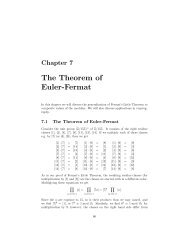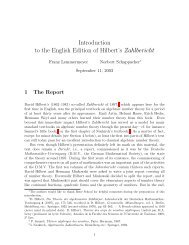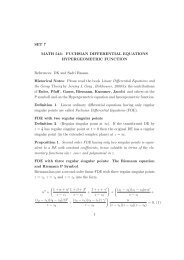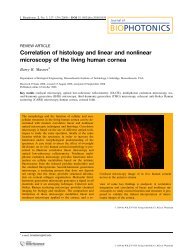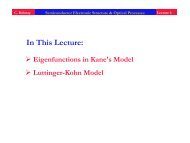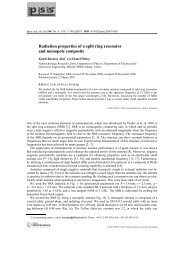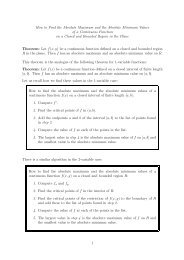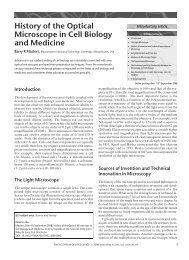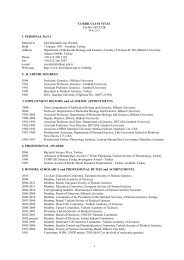MATH 225: DIFFERENTIAL EQUATIONS AND LINEAR ALGEBRA ...
MATH 225: DIFFERENTIAL EQUATIONS AND LINEAR ALGEBRA ...
MATH 225: DIFFERENTIAL EQUATIONS AND LINEAR ALGEBRA ...
You also want an ePaper? Increase the reach of your titles
YUMPU automatically turns print PDFs into web optimized ePapers that Google loves.
<strong>MATH</strong> <strong>225</strong>: <strong>DIFFERENTIAL</strong> <strong>EQUATIONS</strong> <strong>AND</strong> <strong>LINEAR</strong> <strong>ALGEBRA</strong><br />
Solutions of First Midterm Exam<br />
March 13, 2006<br />
1.a) Show that the function y(x) = A + Be x + Ce 2x satisfies the differential<br />
equation y ′′′ − 3y ′′ + 2y ′ = 0, where A, B, and C are arbitrary constants.<br />
Solution:<br />
Hence<br />
y(x) = A + Be x + Ce 2x ,<br />
y ′ (x) = Be x + 2Ce 2x ,<br />
y ′′ (x) = Be x + 4Ce 2x<br />
y ′′′ (x) = Be x + 8Ce 2x<br />
y ′′′ − 3y ′′ + 2y ′ = Be x + 8Ce 2x − 3(Be x + 4Ce 2x ) + 2(Be x + 2Ce 2x ) = 0<br />
1.b) Find the constants A, B, and C so that y(0) = 1, y ′ (0) = −1, y ′′ (0) = 0.<br />
Solution:<br />
y(0) = A + B + C = 1,<br />
y ′ (0) = B + 2C = −1,<br />
y ′′ (0) = B + 4C = 0<br />
There is unique solution A = 5/2, B = −2, C = 1/2.<br />
2.a) Solve the following system by Gauss-Jordan Elimination<br />
Solution :<br />
x1 − 2x2 + x3 − 4x4 = 1,<br />
x1 + 3x2 + 7x3 + 2x4 = 2,<br />
x1 − 12x2 − 11x3 − 16x4 = −1<br />
⎡<br />
1 −2 1 −4<br />
⎤<br />
1<br />
⎡<br />
1 −2 1 −4<br />
⎤<br />
1<br />
⎡<br />
1 −2 1 −4<br />
⎤<br />
1<br />
⎣1<br />
3 7 2 2 ⎦ → ⎣0<br />
5 6 6 1 ⎦ → ⎣0<br />
5 6 6 1⎦<br />
→<br />
1 −12 −11 −16 −1 1 −12 −11 −16 −1 0 0 0 0 0<br />
⎡<br />
1 −2 1 −4<br />
⎤<br />
1<br />
⎡<br />
1 0 17/5 −8/5<br />
⎤<br />
7/5<br />
⎣0<br />
1 6/5 6/5 1/5⎦<br />
→ ⎣0<br />
1 6/5 6/5 1/5⎦<br />
0 0 0 0 0 0 0 0 0 0<br />
Hence the there are infinitely many solutions with two free parameters<br />
x1 = 7 17t 8s<br />
− +<br />
5 5 5 ,<br />
x2 = 1 6t 6s<br />
− −<br />
5 5 5 ,<br />
x3 = t, x4 = s
2.b) What conditions must b1,b2, and b3 satisfy in order for the system<br />
x1 + x2 + 2x3 = b1,<br />
x1<br />
to be consistent. Find the solutions.<br />
+ x3 = b2,<br />
2x1 + x2 + 3x3 = b3<br />
Solution :<br />
⎡<br />
1<br />
⎣1<br />
1<br />
0<br />
2<br />
1<br />
⎤<br />
b1<br />
b2⎦<br />
⎡<br />
1<br />
→ ⎣0<br />
1<br />
−1<br />
2<br />
−1<br />
⎤<br />
b1<br />
b2 − b1⎦<br />
⎡<br />
1<br />
→ ⎣0<br />
1<br />
−1<br />
2<br />
−1<br />
⎤<br />
b1<br />
b2 − b1 ⎦<br />
2 1 3 b3 2 1 3 b3 0 −1 −1 b3 − 2b1<br />
⎡<br />
1<br />
→ ⎣0<br />
1<br />
1<br />
2<br />
1<br />
b1<br />
b1 − b2<br />
⎤<br />
⎦<br />
0 0 0 b1 − b3 + b2<br />
Hence for consistency b3 = b1 + b2. In this case there are infinitely many solutions<br />
x1 = b2 − t, x2 = b1 − b2 + t, x3 = t where t ∈ R is an arbitrary real variable.<br />
3.a) Solve the differential equation x 2 y ′ + 2xy = 5y 4 with y(1) = 1. Discus the<br />
existence and uniqueness of the solution of the differential equation with the initial<br />
condition y(0) = 0.<br />
Solution : Let v(x) = y −3 then<br />
v ′ − 6<br />
x<br />
15<br />
v + = 0<br />
x2 This is a linear equation with the integrating factor ρ(x) = 1<br />
x 6 . Hence the solution<br />
is<br />
v(x) = C x 6 + 15<br />
7<br />
1<br />
x<br />
�<br />
5x<br />
→ y(x) =<br />
7Cx7 + 15<br />
where C is an arbitrary constant. If y(1) = 1 then C = − 8<br />
7 .<br />
The singular solution of this equation is y = 0. Furthermore at x = 0 the existence<br />
and uniqueness is not guaranteed. It is clear from the solution that y(0) = 0 is<br />
satisfied for all C, hence there are infinitely many solutions.<br />
3.b) Solve the differential equation (x + ln y)dx + ( x<br />
y + ey )dy = 0 with y(0) = 1<br />
Solution: M(x, y) = x + ln y and N(x, y) = x<br />
y + ey . Then<br />
but<br />
Fx = M(x, y) = x + ln y → F (x, y) = x2<br />
2<br />
� 1/3<br />
+ x ln y + g(y),<br />
Fy = x<br />
y + g′ = x<br />
y + ey , → F (x, y) = x2<br />
+ x ln y + ey<br />
2
Hence the solution is<br />
x 2<br />
2 + x ln y + ey = C<br />
where C is an arbitrary constant. Since y(0) = 1 then C = e. Therefore the solution<br />
is<br />
x 2<br />
2 + x ln y + ey = e<br />
4.a) Find the Reduced Row-Echelon matrix of the augmented coefficient matrix of<br />
the following system. Then find the solution of the system.<br />
Solution:<br />
x1 + 2x2 + 3x3 = 4,<br />
2x1 + 5x2 + 3x3 = 5,<br />
x1<br />
+ 8x3 = 9<br />
⎡<br />
1 2 3<br />
⎤<br />
4<br />
⎡<br />
1 2 3<br />
⎤<br />
4<br />
⎡<br />
1 2 3<br />
⎤<br />
4<br />
⎡<br />
1 2 3<br />
⎤<br />
4<br />
⎣2<br />
5 3 5⎦<br />
→ ⎣0<br />
1 −3 −3⎦<br />
→ ⎣0<br />
1 −3 −3⎦<br />
→ ⎣0<br />
1 −3 −3⎦<br />
1 0 8 9 1 0 8 9 0 −2 5 5 0 0 −1 −1<br />
⎡<br />
1 0 9<br />
⎤<br />
10<br />
⎡<br />
1 0 0<br />
⎤<br />
1<br />
⎡<br />
1 0 0<br />
⎤<br />
1<br />
→ ⎣0<br />
1 −3 −3⎦<br />
→ ⎣0<br />
1 −3 −3⎦<br />
→ ⎣0<br />
1 0 0⎦<br />
0 0 1 1 0 0 1 1 0 0 1 1<br />
Hence the solution is x1 = 1, x2 = 0, x3 = 1.<br />
4.b) Let XA = Z where A, Z are matrices given by<br />
⎡<br />
0<br />
A = ⎣1<br />
2<br />
−2<br />
2<br />
0<br />
⎤<br />
3<br />
−3⎦<br />
,<br />
4<br />
�<br />
4<br />
Z =<br />
−1<br />
−2<br />
2<br />
�<br />
3<br />
.<br />
0<br />
Find A −1 and the matrix X.<br />
Solution:<br />
⎡<br />
0 −2 3 1 0<br />
⎤<br />
0<br />
⎡<br />
1 2 −3 0 1<br />
⎤<br />
0<br />
⎡<br />
1 2 −3 0 1<br />
⎤<br />
0<br />
⎣1<br />
2 −3 0 1 0⎦<br />
→ ⎣0<br />
−2 3 1 0 0⎦<br />
→ ⎣0<br />
−2 3 1 0 0⎦<br />
2 0 4 0 0 1 2 0 4 0 0 1 0 −4 10 0 −2 1<br />
⎡<br />
1 2 −3 0 1<br />
⎤<br />
0<br />
⎡<br />
1 2 −3 0 1<br />
⎤<br />
0<br />
→ ⎣0<br />
1 −3/2 −1/2 0 0⎦<br />
→ ⎣0<br />
1 −3/2 −1/2 0 0⎦<br />
0 −4 10 0 −2 1 0 0 4 −2 −2 1<br />
⎡<br />
1 0 0 1 1<br />
⎤<br />
0<br />
⎡<br />
1 0 0 1 1<br />
⎤<br />
0<br />
→ ⎣0<br />
1 −3/2 −1/2 0 0 ⎦ → ⎣0<br />
1 0 −5/4 −3/4 3/8⎦<br />
0 0 1 −1/2 −1/2 1/4 0 0 1 −1/2 −1/2 1/4
Hence<br />
A −1 ⎡<br />
1 1<br />
⎤<br />
0<br />
= ⎣−5/4<br />
−3/4 3/8⎦<br />
, then X = ZA<br />
−1/2 −1/2 1/4<br />
−1 =<br />
� �<br />
5 4 0<br />
.<br />
−7/2 −5/2 3/4



